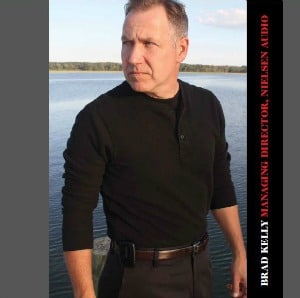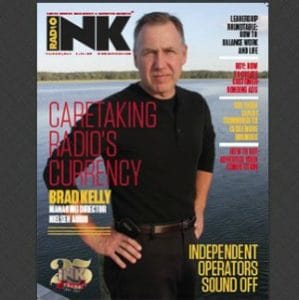
In part three of our three-part preview of Brad Kelly’s Radio Ink cover story interview, we ask Kelly what the giant ratings firm is doing to help radio succeed? after all the radio industry pays bucket loads of cash to Nielsen to produce a product it hopes will be accurate and produce a nice return on their investment. And a growing radio industry is not only good for all of you, it’s good for Nielsen too. So we asked Kelly what’s being done other than collecting listener data and pocketing radio’s cash.
Radio Ink: You have a room full of radio executives, including the most powerful people in radio. What would you say to them?
Kelly: The best way to grow Nielsen Audio is to help the industry grow faster than it otherwise could. And the way I see that happening is to leverage the Nielsen assets. A lot of people think of Nielsen as the ratings company, but that’s only a third of what we do. The other two-thirds of this company is the buy side of the business, working with major advertisers like Johnson & Johnson, Kraft, Procter & Gamble, and Nestle. These are customers of ours who spend a lot of money with Nielsen and rely on Nielsen for their consultation. We need to start breaking down those barriers.
Audio is kind of a silo, but if we can start to engage that side of the business and introduce radio to these advertisers, many of whom are spending billions of dollars in advertising — with little or none of it going to radio, for whatever reason — that will be time well spent.
When Nielsen added radio to its portfolio with the acquisition, something really important happened. The last piece of the puzzle dropped into place. There is media consumption for everything else Nielsen is measuring, evaluating, scoping, and scaling, and there is this chunk in the middle that all of a sudden has dropped in, and it has completed the picture of media consumption and product consumption.
With Arbitron, it was just radio. It was a silo, and it did not commingle with anything, but now this is not just about radio anymore. Now we have the broader view, the mosaic, and where radio fits into that picture. It’s now about creating the linkage points with all other media and all other consumer behavior that Nielsen is collecting and tracking.
So when we put out a comparable-metrics report and it says radio is a top weekly reach medium, that has context now because Nielsen is measuring them all and can lay radio side-by-side with TV and digital and mobile.
Radio Ink: So what does all of this mean?
Kelly: It elevates the profile of this medium in a way I don’t think we’ve seen in the past. We now have the ability to link radio data to all of these other data sources — millions of product-purchase transactions through Nielsen Catalina, linking radio data to credit card transactions for the first time ever.
We have the opportunity to quantify the return on ad spend with radio. I spend a dollar on radio, what can I expect to get back in return? We can see now how radio augments the recall of TV ads and how the two fit together to create something more impactful for advertisers. We’re learning about the value of recency, having heard the message recently, right before the point of purchase, and how that impacts the decision-making process.
So what we have is a body of work now that has helped us understand, not what you already know, which is that radio works, but more importantly, how and why radio works. We put this into the 6 R’s of Radio piece that you were so kind to showcase for us at the Hispanic Radio Conference, which has gone viral. It has been shared, liked, linked, and re-tweeted thousands of times. It’s part of the sales kit.
But it’s not enough to do these studies and throw them out there. We know that we have to get them in the hands of the right people. Who are the right people? Big, billion-dollar advertisers who don’t use radio. How do we get to them? What we’ve found out is the right people are the Nielsen people. These are clients. They have their own rep teams, and sometimes dozens of people who work on these extremely large accounts.
So what I’ve been doing is crossing over to the buy side of the business. I’m participating in their meetings, listening to the issues and concerns, but also talking about audio and explaining that they have a new tool in their toolkit, and it’s called audio. We are meeting face-to-face with these extremely large advertisers.
Radio Ink: And is it working? Will we see new advertisers, as a result of what you’re doing, come to radio?
Kelly: It’s having an effect. They are hungry for more information. They are now taking a fresh look at radio, in some cases where they have not spent a dime on radio since the days of old. From what I’m hearing in these meetings, digital is falling out of favor.
They’re realizing that they’re buying the same consumers over and over again. One of the quotes I have heard is, “We are writing checks that these guys aren’t able to cash.” They are not happy with the lack of accountability, the lack of standardization, the lack of independent metrics they are getting from digital. Placement is an issue. They don’t want their logo slapped up against ugly hate speech. They realize they’re spending too much time at the bottom of the sales funnel, hitting the same people. They are saying to us, “We need to move back up to the top of the funnel. We are mass merchandisers, and we need to get back to mass media. We want incremental reach.”
They want to reach ethnic audiences. They’re looking for ways to deliver the message to the consumer who is going to purchase. They want to deliver the message at the right moment, when the consumer is in that purchase-making mode, when they are getting out of the car and walking in. They want accountability. They want reach while still being targetable.
I’m listening to this and realizing these are so many of radio’s key strengths. I’m no dummy, so I take all this and put it into what we’re referring to as the Brand Manager’s Guide to Radio. This is a primer for brand managers to re-acclimate them about what radio is.
Radio Ink: Why are advertisers meeting with you? What are they looking for?
Kelly: These advertisers are meeting with me because I’m not threatening to them. I’m part of their Nielsen solution team, and I’m not pitching a schedule. I’m a resource to help educate them. The next step in the process is for the industry collectively to step up, put its best foot forward, and make a case for why radio can deliver solutions to their toughest challenges. At that point the environment will have evolved to where somebody’s going to have to make the pitch and ask for the order.
When it gets to that point, the thing I’m asking my customers is, “What are you going to say? What does that pitch sound like? Are we ready and able to speak the language that these people are comfortable with?” That’s something we need to think about right now.
Bottom line, the environment is right, the winds are shifting and blowing favorably in our direction. The table is being set, but if there is no follow-through, it will come to nothing. I don’t believe there has ever been a better time to be in the radio industry, and that is not just smoke. I believe that to my core. Collectively, we have an opportunity to make 2017 a tipping point in a very positive way for the radio industry.
Read Part One (What is the Perfect PPM Size HERE).
Read Part Two (Pandora and Radio are Not Equals HERE)
To subscribe to Radio Ink magazine and have this interview and the entire May 22 issue downloaded to your digital device today GO HERE






